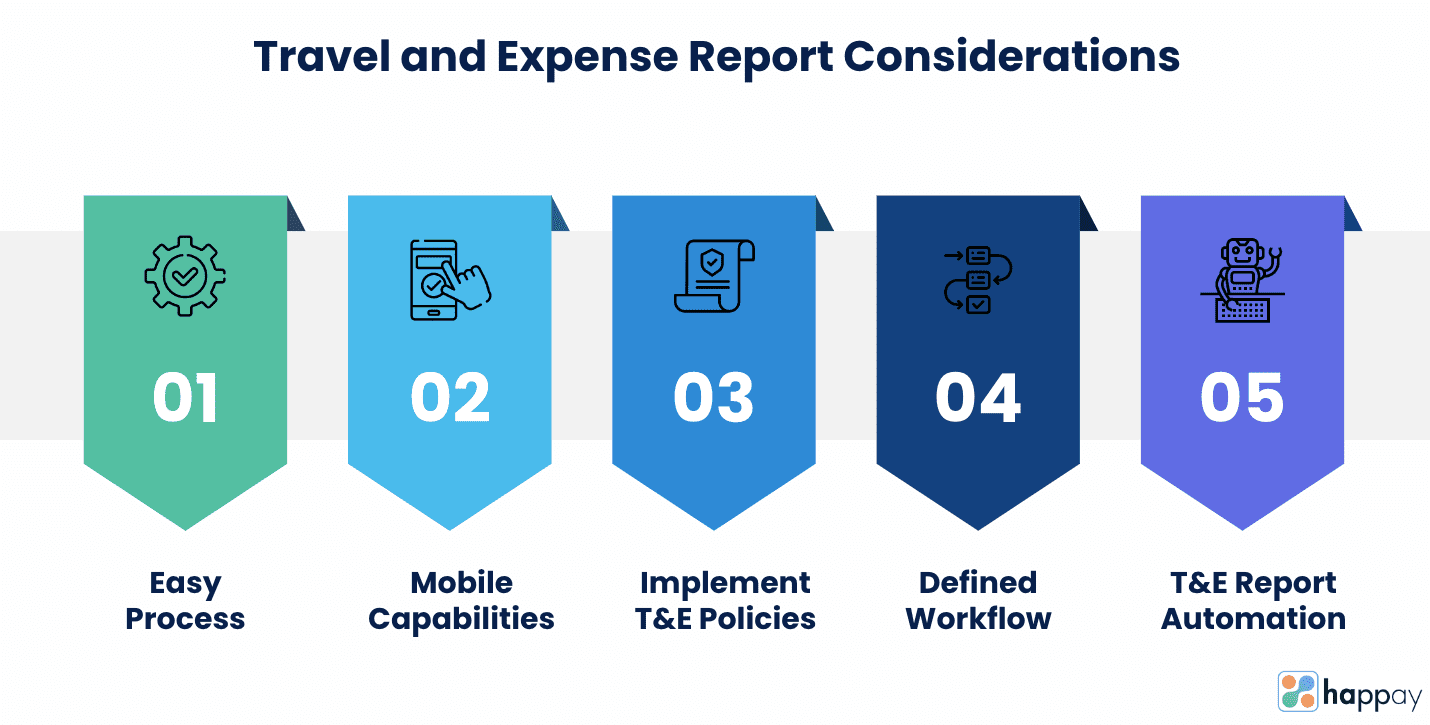Last Updated on November 28, 2025
Travel Expense Report
The second biggest cost factor of a business that often goes unnoticed is not salaries or operating expenses but a secret third thing- business travel expenses.
Travel expenses exhaust a large chunk of a company’s budget. A study by Certify shows that there are about 445 million business trips every year. However, you will be surprised to know that most large enterprises don’t even have a proper system to track and process travel expense reports accurately.
Efficient processing of T&E reports can help you maximize savings and plug cost leakages. Automating key components of the system can yield high ROI (return on investment). Then why do companies with a multitude of resources willingly miss out on mammoth savings?
It is a mystery you don’t have to be a part of.
Tired of excel sheets, email back and forth and a cumbersome travel expense reports process? You’ve arrived at the right place!
Read the entire blog to learn what is a travel expense report, its importance, and why you should automate it.
Also, Read: A Guide to Travel and Expense Management
What is a Travel Expense Report?
A travel expense report is a document that itemizes all the expenses incurred by the employee. Employees usually submit travel and expense reports in a digital or paper format to claim reimbursement on business expenses they paid for.
To better understand how travel expense reports work, here’s an example:
Consider that your boss has asked you to go to Australia for a sales conference. He says that you can pay for all expenses out of your own pocket for now and file for reimbursement later. You pay for your airline tickets, hotel accommodation, meals, and other legitimate expenses.
Now, to get reimbursement for these business costs, you have to submit a report to the manager and the finance department. While filing the claim, you must ensure that the report is compliant with the travel and expense policy of the firm.
What does a Travel and Expense Report contain?
Here are the elements of a travel and expense report. All of these elements are essential for the reimbursements to be validated and processed.
- Purchase date
- Name of the vendor
- Category name
- Name of the employee
- GST (in India)
- Subtotal
- Total sum
- Receipt or invoice
Why are T&E Reports important in business travel?
T&E reports are a vital cog in the corporate travel management wheel for companies of all sizes. While small businesses can rely on the savings efficient T&E report processing brings, medium and large businesses can use them to prevent frauds and access crucial data.
Most firms set aside 10% of their annual budget for T&E. The travel and expense money is paid to employees before the trip begins as advance or reimbursed post-trip. Here’s why travel and expense reports are a crucial part of corporate travel management –
a) Facilitate reimbursement
Unless a travel expense report is filed, employees cannot get reimbursement on the payments they made during their business trip.
b) Reduction of fraud
The chances of expense fraud are pretty high while reimbursement processing. Employees can overstate expenses or duplicate receipts to get more than what they are due. However, by implementing the right travel and expense policy, you can prevent the occurrences of such fraud.
c) To access important data
As a CFO or finance official, you can use travel expense reports to keep track of your current expenses and forecast future expenses. Additionally, these reports help you understand if you are within your T&E budget.
Also, suppose you’re overshooting your budget. In that case, you can use the reports to identify the categories where you’re spending too much and reduce expenses.
d) Reduce tax
In most countries, expenses incurred for business are tax deductible. This is where having a detailed travel and expense report can help you. You can obtain tax deductions during tax season by submitting detailed expense reports.
Advanced T&E solutions also have GST modules. Happay’s GST module allows you to claim ITC on every rupee spent.
Also, Read: Best Use of Happay T&E Analytics
How to report T&E Expenses?
1. Travel and expense report template
In some organizations, employees continue to report expenses using Microsoft excel and basic travel expense report templates. Depending on the firm, it could be a monthly, quarterly, or annual travel expense reporting template.
This could work well for a small business, but in an enterprise, the entire process is stressful if you’re doing it manually. Even in a small business, manual processes can cause delays in reimbursements causing employees to bear the financial burden for longer than they can manage.
2. Travel expense management software
If you’re looking to streamline the business travel expense reporting process in your company, using expense management software is your best bet. In companies where travel and expense management software is used, employees can file expense reports on the go using their mobile. And managers can approve the report with a single click.
Expense management software make the reimbursement process easy for both employees and approving managers.
Things to consider while creating a Travel and Expense Report
Here are some of the things organizations must consider while creating a travel and expense report:

1. Ensure the travel and expense reporting process is easy
We can’t stress this enough – ensure your firm’s travel and expense reporting process is straightforward. Do not follow a process that is complicated to follow.
2. Add mobile capabilities
Mobile phones have become an integral part of our everyday lives. Therefore, ensure the expense management system you choose has OCR features and other mobile capabilities.
3. Implement clear T&E policies
You can simplify the T&E reporting process in your firm by implementing clearly defined travel and expense policies.
4. Workflow
Creating a defined workflow can make the expense reimbursement process hassle-free in your firm.
5. Automate
Automating your travel and expense reporting process can help you simplify multiple tasks and also help you save big.
Quick Read: Travel and Expense Automation
Why should you automate your Travel and Expense Reports?
If you work in a large firm with a sizeable number of employees making frequent business trips, you would already have a travel & expense reporting and processing mechanism in place. It could be a manual method, or partially automated.
According to an Association of Certified Fraud Examiners study, 21% of frauds in small businesses happen in reimbursements. It is comparatively less in large organizations – it accounts for 11%, but still a huge number.
Ironically, this fraud can happen at any level. Anyone could commit expense fraud, from a simple sales employee to a top-level manager. Expense fraud includes submitting duplicate receipts, fake bills, altering expense reports and others. Here’s a detailed look at why you need to automate your company’s T&E reports:
- Automated expense reports reduce plenty of paperwork and reporting time. Your employees don’t have to submit original bills, receipts, or invoices and fill out countless forms for reimbursement.
- Most automated expense management systems can auto-populate the report using pictures uploaded by the employee and invoices from Gmail and Outlook. Instead of taking an entire day to fill reimbursement form and submit the T&E report, your employees can now file them on the go, from anywhere, anytime.
- An automated expense management tool can ensure all the expenses filed by the employee comply with your company’s spending policy. Most automated systems flag expenses that violate company policies in real-time. Your managers and finance team can now quickly look at that expense and decide if they should reimburse or not.
- Using an automated T&E management system, you can drastically reduce or eliminate fraudulent claims from some employees.
- Expense reimbursement is a process that your employees and the finance department hate. But, thanks to expense management software, expense reporting and reimbursement processes are now simple.
Must-have features in a Travel Expense Management System
For easy understanding, let’s split the T&E reports into three parts. Namely, pre-trip, on-trip and post-trip. Make sure the TEM system you choose has the features mentioned below in these categories:

Pre-trip
- Allows multiple users: Always choose an expense management system that will enable you to add multiple users and lets you add roles to each of them. For example, your admin can give the managers and the finance department approval powers. In comparison, the role of employees should ideally be restricted to just submitting the reports.
- Allows you to implement T&E policies: A good expense management software should allow you to add your firm’s T&E policies into the system. Using this feature, you can set expense types, per diem limit, expense limits, spend frequency, cut-off dates, etc. This feature can help prevent expense fraud and increase policy compliance rates in your organization.
On-trip
- Auto categorization: Choose an expense management system that will auto-categorize expenses in the report. Also, pick expense management software where you can add a vendor for a particular category. The system will automatically detect the bill from the specific vendor and add the expenses in the correct category without manual intervention.
- Auto scanning of receipts/ Optical Character Recognition (OCR) technology: Most T&E management software has in-built OCR technology. The OCR technology will extract important data like date, money spent, vendor name, etc. With OCR, your employees no longer have to worry about manually filing the bills and receipts and bills. They only need to take a picture of the bill or receipt.
- Record mileage expenses: If your employee uses his personal vehicle for business, use an expense management system with a GPS tracking system to track and record mileage and pay as per the mileage rates.
Post-trip
- Automated expense report: Manually creating an expense report after a trip is a massive task for your employees, and most often, they end up spending a lot of time creating one. Therefore, it’s best to use an expense system that automates the entire process and makes it effortless for employees.
- Auto rejection and approval: Expense management software allows the approvers to set auto rejection and approval for reports based on the organization’s travel policy. For example, the approver can select auto-approval for reports that follow the policies and reject reports that violate them.
- Integration to other apps: Always pick a system that allows you to integrate into your apps. By doing so, you can seamlessly transfer data between the expense management system and other software such as ERP, accounting, payroll, HR, etc.
- Advanced analytics: Using a travel and expense management system, you can get real-time data on how much you’re spending, categories you’re overspending, employees violating policies and more.
Also, Read: Travel Policy for Employees in India
Best practices for Travel Expense Tracking and Reporting
Looking to make your travel and expense management reports error-free and accurate. Here are some of the best practices for T&E tracking and reporting:
1. Use the right expense management system
Choosing the right expense management system is the most crucial aspect of your expense reporting and tracking process. For error-free reporting and tracking, it’s always best to choose an automated expense reporting system. According to a study, robotic process automation can save finance teams about 25,000 hours of rework from human errors.
2. Book all your travel in one place
Using expense management software, your employees can now book all the tickets without much hassle. It’s easier for you to track and approve travel-related expenses if the booking is made through a T&E management system.
3. Update your T&E policy
Make sure you include your firm’s travel and expense policy in the system. This way, the employee will be notified of a policy violation when he files a report. Moreover, having a digitized T&E policy in place can increase your firm’s policy compliance rates.
How to save money on Travel Expenses?
If you are looking to save big bucks on business travel expenses, using an automated T&E expense management system like Happay is the way to go. Happay offers you centralized visibility, which means you have greater control over business travel-related expenses.
Also, you can eliminate cash leakages in your firm thanks to Happay’s automated policy enforcement. Using Happay’s smart audit features you can now reduce your expense verification time by up to 80%. Want to know how? Schedule a demo with Happay now and find out how much money you can save.
Travel and Expense Report – FAQs
T&E stands for travel and expenses report. The report contains the total expense incurred by the employee while on a business trip.
Some examples of travel expenses are airfare, transportation, meals, fuel, etc. Employees can add the following expenditures in their expense reports and claim reimbursement.
Yes. Business-related travel can be included in business expenses. The money spent on flight, train or bus tickets is part of this expense.
Some T&E software can be expensive. However, if you’re a huge firm and don’t have fully automated expense reporting software, you could save a lot of money by investing in one.










Discussion about this post